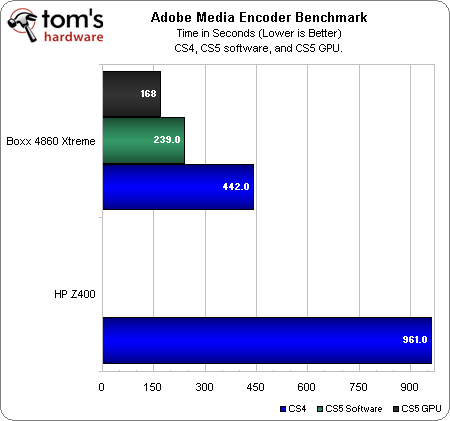Boxx Technologies 3DBOXX 4860 Workstation
Benchmark Results: Adobe Premiere Pro, After Effects, And Photoshop
We have three tests that use Premiere: two custom tests that were originally written for CS4 and are shown here in both CS4 and CS5, and the CS5-only Paladin test supplied by Adobe.
Paladin Test
The “Paladin” test is an effects-heavy (but comparatively I/O-light) metric that primarily stresses the graphics card's ability to leverage the Mercury Playback Engine in CS5. We will continue to use this to benchmark CUDA performance on workstations moving forward.
Tom’s Premiere Test
This custom workload is a montage edit of various footage shot around Los Angeles on a Panasonic HVX200 camcorder. The source footage is 1280x720 at 60 FPS, compressed using DVCProHD at 100 Mb/s. There are various transitions, color correction, and cuts between multiple clips (which should stress the drive, due to random access becoming a factor.)
Even though this system’s render time is dramatically faster when using software, the CUDA-enabled render time of 26.6 seconds shows how much additional performance this can offer.
Adobe Premiere/ Adobe Media Encoder Export Test
Get Tom's Hardware's best news and in-depth reviews, straight to your inbox.
This test takes the same edit as above and encodes it to H.264 for Blu-ray. The CS5 software time shows a dramatic improvement over CS4, and using the CUDA acceleration inherent to the Mercury Playback Engine trims even more time (though not as dramatically as it does in the editing test above.)
Adobe After Effects Motion Graphics Test
This is a standard definition sequence with a large 2D image being panned over in the background, while three video sequences are played in the foreground. The video sequences are 720p HD clips in DVCProHD format.
The first thing to notice is that the 3DBOXX 4860 took longer in the CS4 conventional render than the z400. This is possibly due to issues discussed by Chris Angelini in his Westmere review. The multiframe render, where each processor core is given its own frame to render in its own memory space, makes a much more efficient use of the processor cores, yielding a result much more consistent with the difference in processor speed.
After Effects CS5 offers a much faster render with very little visual difference between the two engines. The single-frame render is literally a tenth the time of the same render in CS4, and the multiframe render is about a fifth of the CS4 time. This is a drastic increase in performance that should be in and of itself enough reason for any After Effects user to upgrade to CS5.
Adobe Photoshop
The standard Tom’s Hardware Photoshop test uses a scripted action to run several filters on a large image.
The test shows similar results in both CS4 and CS5. Since it doesn’t test interactivity or large memory space, many of the changes between CS4 and CS5 are not seen.
Current page: Benchmark Results: Adobe Premiere Pro, After Effects, And Photoshop
Prev Page Benchmark Results: SPEC Tests Next Page Benchmark Results: DAW-
nebun what a cheap cpu cooler they have....really...for 8k they could have installed a better cooling systemReply -
utengineer mayankleoboy1though if i were to take each component separately and build our own system, it would be cheaper.You forget, the cost of a commercial PC includes service, support, and licensed certifications.Reply
-
nforce4max I wouldn't purchase this workstation. First you can build a better base machine for the fraction of the cost. Second you can purchase on your own the software you require or pirate. Third there is a flaw, yes there is always the temptation of mounting the hard drives in that manor but isn't recommended due to the uneven wear on the spindle that can lead to early failure.Reply -
For this price, I'd go with a workstation from a major player (ex. HP or similar). You could easily build a dual socket workstation with similar (or better) overall performance; remember that many apps that require this level of hardware are optimized for Xeon instruction sets and 8+ threads. Additionally, you're software vendors would actually support their products on a system running within spec. Simply put, this is a toy not an enterprise class productReply
-
wiyosaya utengineerYou forget, the cost of a commercial PC includes service, support, and licensed certifications.Licensed certifications may be confidence inspiring to some, however, I think they are a waste of money. It is just a different form of branding that can be marketed at what is usually an expensive premium. Think THX certification. It was expensive in consumer audio and video, however, in my opinion, it has had it's 15-minutes of fame.Reply




